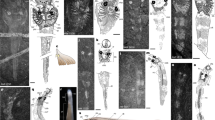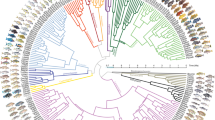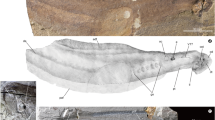Abstract
NOT all lampreys migrate to the sea. Some (the ‘landlocked’) always remain in fresh water; but after metamorphosis they migrate from the brooks, where they are born, to lakes and rivers. After a long feeding period they go back to the brooks, where they spawn and then die. This is known to happen with Petromyzon marinus, the landlocked form of which multiplied abundantly and spread widely in the Great Lakes of North America1. The same phenomenon was recorded for Lampetra fluviatilis of Lakes Ladoga and Onega in the U.S.S.R.2
This is a preview of subscription content, access via your institution
Access options
Subscribe to this journal
Receive 51 print issues and online access
$199.00 per year
only $3.90 per issue
Buy this article
- Purchase on SpringerLink
- Instant access to full article PDF
Prices may be subject to local taxes which are calculated during checkout
Similar content being viewed by others
References
Applegate, V. C., and Moffett, J. W., Sci. Amer., 192, 4, 36 (1955).
Berg, L. S., Ann. Mus. Zool. Acad. Sci. U.R.S.S., I, 87 (1931).
Zanandrea, G., Pubbl. Staz. Zool. Napoli, 31, 127 (1959).
Young, J. Z., “The Life of Vertebrates” (Oxf. Univ. Press, 1950)
Leach, W. J., J. Morph., 89, 2, 217 (1951)
Zanandrea, G., Boll. di Zool., 23, 414 (1956); Atti Instit. Ven. L. Sci., A., 116, 180 (1958); Nature, 179, 928 (1957).
Author information
Authors and Affiliations
Rights and permissions
About this article
Cite this article
GIUSEPPE ZANANDREA, S. Speciation among Lampreys. Nature 184, 380 (1959). https://doi.org/10.1038/184380a0
Issue Date:
DOI: https://doi.org/10.1038/184380a0
This article is cited by
-
A new element in the migration cycle of the European river lamprey Lampetra fluviatilis: downstream migration from a lake
Environmental Biology of Fishes (2022)
-
The Southern Hemisphere lampreys (Geotriidae and Mordaciidae)
Reviews in Fish Biology and Fisheries (2021)
-
MtDNA markers reveal the existence of allopatric evolutionary lineages in the threatened lampreys Lampetra fluviatilis (L.) and Lampetra planeri (Bloch) in the Iberian glacial refugium
Conservation Genetics (2011)
-
Characterization of 14 microsatellite loci in the paired lamprey species Ichthyomyzon unicuspis and I. fossor and cross amplification in four other Ichthyomyzon species
Conservation Genetics Resources (2009)
-
Mature dwarf males and females of the arctic lamprey,Lethenteron japonicum
Ichthyological Research (1998)
Comments
By submitting a comment you agree to abide by our Terms and Community Guidelines. If you find something abusive or that does not comply with our terms or guidelines please flag it as inappropriate.



